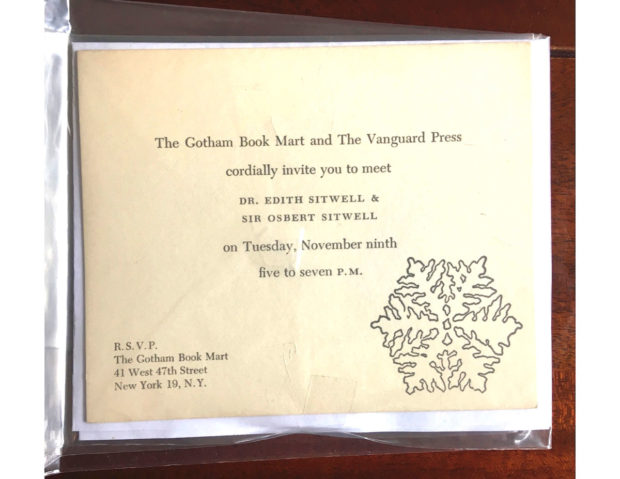
Courtesy of Erwin Tiongson
NEW YORK—As an aspiring writer in the 1970s, I would occasionally visit the Gotham Book Mart on West 47th Street in Manhattan. It wasn’t necessarily to purchase books, as there were then the Strand and a nearby gaggle of second-hand bookstores in Greenwich Village, where I lived. The Strand still stands, thankfully, but most of the second-hand shops are gone.
I went to the Gotham as a kind of literary pilgrimage: it was the city’s most storied bookseller, a cultural destination and the solitary purveyor of literature on a block crowded with jewelry stores and diamond merchants. A sign above the door read, “Wise Men Fish Here.” More than a bookseller, the Gotham was a literary salon, where writers read from their newly published books, and where the James Joyce Society held its meetings. The Gotham, alas, went the way of most indie bookstores and folded in 2007, a casualty of rising commercial rents, mismanagement, and the increasing popularity of online book-selling.
Certainly well-known (and the not-so-well-known) authors and celebrities came to browse its stacks, among them Jackie Kennedy, Arthur Miller, Anais Nin, Dylan Thomas, John Updike, Katherine Hepburn, Jean Cocteau, and José Garcia Villa, who passed away in 1997. He’s the only Asian listed in Wikipedia’s enumeration of the literati and the glitterati who patronized the place. And his is the only Asian face peering at the viewer, in a 1948 photograph taken at the store—one that some have described as the most famous photograph of 20th century poets, in the English language, at any rate. His fellow poets included W.H. Auden, Marianne Moore, Elizabeth Bishop, Dame Edith Sitwell, Randall Jarrell, and Delmore Schwartz.
The iconic photograph by Lisa Larsen was included in the 2008 Penguin edition of Villa’s works, José Garcia Villa: Doveglion: Collected Poems, edited by the late John Cowen, Villa’s longtime student and literary executor, and with an introduction I wrote.
Except for the Manila-born Villa, all of the writers included were white, either from the United States or from the United Kingdom. To see the premises of where that famous photograph was taken, and inspect it closely was one reason I would visit the Gotham. I knew Villa, as I had studied with him in the early ‘70s at both the New School and in his workshop at his Greenwich Village flat. I assumed the taking of the photograph was a fairly routine affair, assembling the poets, gathered there for a cocktail party in honor of Dame Edith Sitwell and her brother Sir Osbert, to pose for the camera.
But I never realized how contentious the proceedings were until I read Erwin Tiongson’s meticulously researched account published in Slate last month. There were more writers at the party than those photographed, the criterion for inclusion being you had to be a poet. Intense jockeying ensued, but the line held: only poets! Thus, for instance, William Saroyan was excluded from the photo, infuriating him and leading him to vow that he would never fish at the Gotham again. Strangely, William Carlos Williams was excluded as well.
No one raised a fuss about Villa’s inclusion, as he had already been heralded as a shining star in New York’s poetry firmament. His Have Come, Am Here was published by Viking Press in 1942, to critical praise, and was shortlisted for the 1943 Pulitzer Prize. Villa believed that he was denied the prize due to his not being an American citizen. The famously acerbic bard would reap other honors and in 1973 be honored by the Philippine government as a National Artist for Literature.
You can read Tiongson’s fascinating piece here as well as view the photograph.
https://slate.com/culture/2019/12/photo-elizabeth-bishop-marianne-moore-auden-tennessee-williams.html
In an e-mail to me, Erwin added this bit that he said had been dropped from Slate due to length: “Nearly two decades earlier, he [Villa] was editor of a mimeographed literary journal, Clay, and had published, remarkably, a poem by the young Saroyan (now remembered as a fiction writer) and a short story by the young William Carlos Williams (now remembered as a poet).”
Erwin and his wife Titchie Carandang run the Philippines on the Potomac Project (POPDC), which since 2013 seeks to document the history of Filipinos and Filipino-Americans in the nation’s capital. It was while researching the wartime Philippine government in exile, headed by Manuel L. Quezon and for which Villa worked for a year, that Erwin came across the back story, or as he puts it, “back stories,” of the photograph. (A copy of the invitation to the Sitwell party pictured here is courtesy of Erwin.)
One can find out more about the fascinating stories they have unearthed on their FaceBook site, https://www.facebook.com/ThePOPDCProject/
Copyright @ L.H. Francia 2020
Top of Form
Bottom of Form
Top of Form
Top of Form
Bottom of Form

